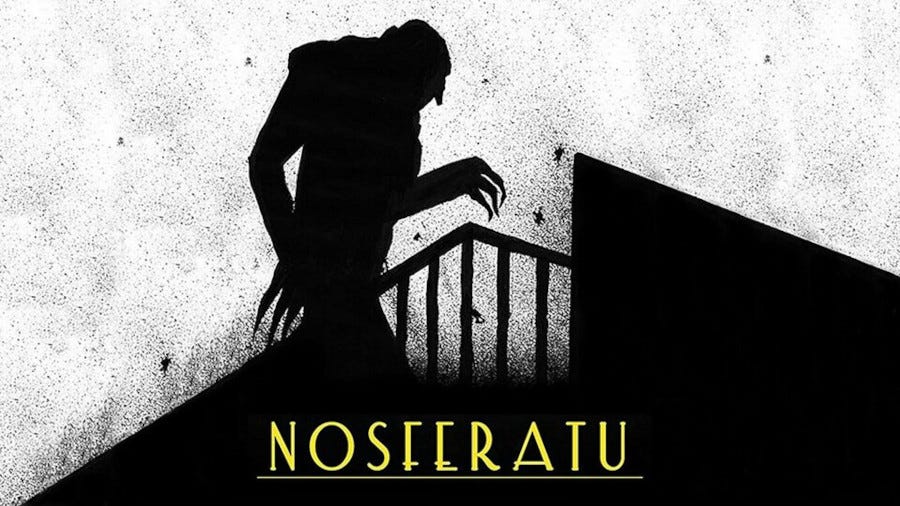Stream On: When was Dracula not Dracula? ‘Nosferatu’
Look for a restored, tinted version of this horrifying 1922 silent version of ‘Dracula.’
The silent 1922 German expressionist movie Nosferatu is still one of the best adaptations of Bram Stoker’s 1897 novel Dracula out there: otherworldly, atmospheric and terrifying, it was ordered destroyed by Bram Stoker’s widow, who hadn’t sanctioned it. But like its subject, the vampire Nosferatu, the film rose from the dead and is with us still.
NOSFERATU: A SYMPHONY OF HORROR
/Streaming /Archive.org /Amazon /😎97%😌87% /Trailer /1922 /NR
“Nosferatu: Does this name not sound like the deathbird calling your name at midnight? Beware you never say it—for then the pictures of life will fade to shadows, haunting dreams will climb forth from your heart and feed on your blood.”
The name “Nosferatu” is a consequence of Bram Stoker’s widow not approving this movie based on her late husband’s novel Dracula (she was his literary executor). The names of all the characters had been changed, but it wasn’t enough. Finding out about the German-market film after its release, Florence Stoker won a lawsuit in Germany ordering that all copies and negatives of Nosferatu be destroyed. But no one ever provided any physical evidence that the film had actually been destroyed.
The story begins with Thomas Hutter (Jonathan Harker in Stoker’s novel; here oddly played by Gustav von Wangenheim), a young real estate agent who is sent to Transylvania to facilitate a property deal with the enigmatic Count Orlok (or Dracula). As Hutter travels to Orlok’s eerie castle, he encounters locals who warn him of the Count's sinister reputation. Undeterred, he arrives at the castle, where he meets the unsettling Orlok (played chillingly by Max Schreck. an actor who inhabited “a remote and incorporeal world” and spent time walking through forests), pallid and rat-like.
During Hutter's stay, he discovers Orlok’s true nature when he finds a series of disturbing clues, including coffins filled with soil and an ominous encounter with the Count himself, who bites Hutter and appears to possess supernatural powers. After signing the real estate papers, Hutter returns home to Wisborg, but Orlok follows him, bringing with him a plague that will decimate the town.
Upon arriving in Wisborg, Orlok moves into the estate adjacent to Hutter and his wife, Ellen (a very good Greta Schröder). His presence begins to wreak havoc; mysterious deaths occur, and an unnatural fear spreads through the town as the vampire preys upon its citizens. Ellen, who has a deep connection to her husband and senses the dark threat posed by Orlok, becomes increasingly aware of the danger.
The film is marked by groundbreaking German expressionist cinematography, of a dark, askew world; an atmospheric score, and haunting imagery. The black-and-white scenes were color-tinted, in a common practice of the time. (The trailer shows such tinting.) Amber marked indoor scenes; blue was nighttime; pink was sunrise, or sunny days, etc. In Nosferatu the tints add to the feeling of otherworldliness and after a few minutes, the archaic mechanics of a silent movie from 1922 vanish and the horrifying narrative will shake you like a terrier does a rat.
And speaking of rats, the theme of plague, accompanied by the rats that pour horrifyingly out of Orlok’s soil-filled coffins, is invoked in tandem with the plot-line of Orlok “infesting” an “innocent” neighborhood. (Original audiences were only as removed from the deadly 1918 Spanish flu pandemic as we are now from COVID19.)
Nosferatu is a classic in the horror genre and an enduring influence on subsequent vampire films. The film itself is in the public domain since 2019, and some of the free-with-ads Roku channels will show you a faded print without tinting. There are many versions available now, some in sharp, clear black and white, some tinted. (The excellent version I watched on Archive.org—and downloaded and burned to a DVD—was restored in the 1990s to crisp tinted video with new English interstitial titles and a new performance of the score.)
Bottom line: if you pay a few dollars you’re more likely to see a well-restored, tinted title, instead of the faded prints that are also out there. It’s well worth it!
Sources include Wikipedia (CC BY-SA 4.0 DEED).
Pete Hummers is a participant in the Amazon Services LLC Associates Program, an affiliate advertising program designed to earn fees by linking Amazon.com and affiliate sites. This adds nothing to Amazon's prices. This column originally appeared on The Outer Banks Voice.


